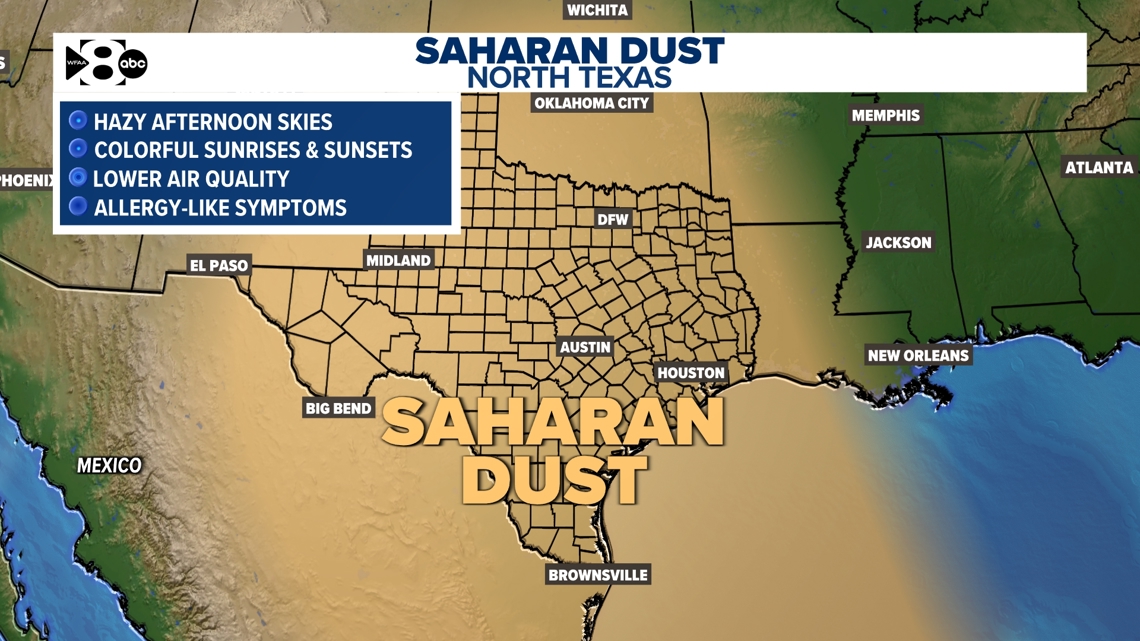Saharan Dust Cloud: Understanding Its North Texas Arrival

Welcome to your ultimate source for breaking news, trending updates, and in-depth stories from around the world. Whether it's politics, technology, entertainment, sports, or lifestyle, we bring you real-time updates that keep you informed and ahead of the curve.
Our team works tirelessly to ensure you never miss a moment. From the latest developments in global events to the most talked-about topics on social media, our news platform is designed to deliver accurate and timely information, all in one place.
Stay in the know and join thousands of readers who trust us for reliable, up-to-date content. Explore our expertly curated articles and dive deeper into the stories that matter to you. Visit Best Website now and be part of the conversation. Don't miss out on the headlines that shape our world!
Table of Contents
Saharan Dust Cloud: Understanding its North Texas Arrival
North Texas residents recently experienced a hazy, orange-tinged sky, a phenomenon caused by the arrival of a Saharan dust cloud. This massive plume of dust, originating from the Sahara Desert in Africa, travels thousands of miles across the Atlantic Ocean, impacting air quality and weather patterns across the Caribbean and the southern United States. This article will explore the science behind these dust clouds, their impact on North Texas, and what residents can expect.
What is a Saharan Dust Cloud?
Saharan dust, or the Saharan Air Layer (SAL), is a massive body of dry, dusty air that forms over the Sahara Desert during the summer months. Driven by strong winds, it can stretch for thousands of miles, transporting millions of tons of sand and dust particles across the Atlantic. This natural phenomenon isn't new; it's a recurring event, but its intensity and reach can vary year to year. The dust is composed of fine mineral particles, including clay, silt, and sand. These particles are so fine that they can remain suspended in the atmosphere for extended periods, traveling vast distances.
The Journey to North Texas:
The journey of a Saharan dust cloud is a fascinating meteorological event. The dust is initially lifted by strong winds associated with the African easterly jet stream. These winds propel the dust across the Atlantic, sometimes reaching as far as the Gulf Coast and beyond. The intensity of the cloud often diminishes as it moves further away from its source, but even attenuated clouds can still significantly impact air quality. This year's arrival in North Texas was particularly noticeable due to the density and concentration of the dust particles.
Impact on North Texas:
The arrival of a Saharan dust cloud in North Texas has several notable effects:
- Reduced Air Quality: The high concentration of dust particles can decrease air quality, potentially causing respiratory problems for sensitive individuals, such as those with asthma or other lung conditions. [Link to local air quality monitoring website] provides real-time updates on air quality.
- Haziness and Reduced Visibility: The dust creates a hazy, orange-tinged sky, reducing visibility and affecting the appearance of sunrises and sunsets. This can also impact air travel and other outdoor activities.
- Impact on Weather: While the dust itself doesn't directly cause rain, it can influence weather patterns. Some studies suggest that Saharan dust can suppress hurricane formation in the Atlantic by stabilizing the atmosphere. However, further research is needed to fully understand these complex interactions.
- Potential Benefits: Counterintuitively, Saharan dust can also have some positive effects. The dust particles contain nutrients like iron and phosphorus, which can fertilize the Amazon rainforest upon deposition.
What to Do During a Saharan Dust Event:
During periods of high dust concentration, it's crucial to take precautions to protect your health:
- Limit outdoor activities: If you have respiratory issues, minimize time spent outdoors, especially during peak dust concentrations.
- Monitor air quality: Check your local air quality reports regularly and adjust your activities accordingly.
- Stay hydrated: Drink plenty of water to help flush out your system.
- Use air conditioning: If possible, use air conditioning to filter the air indoors.
Conclusion:
The arrival of the Saharan dust cloud in North Texas is a testament to the interconnectedness of global weather systems. While the dust can cause temporary disruptions to air quality and visibility, it's a natural phenomenon that has been occurring for millennia. By understanding the science behind these events and taking appropriate precautions, residents can mitigate the potential negative impacts and appreciate the remarkable journey of these dust particles across the vast expanse of the Atlantic Ocean. Stay informed about future dust events by following your local news and weather forecasts.

Thank you for visiting our website, your trusted source for the latest updates and in-depth coverage on Saharan Dust Cloud: Understanding Its North Texas Arrival. We're committed to keeping you informed with timely and accurate information to meet your curiosity and needs.
If you have any questions, suggestions, or feedback, we'd love to hear from you. Your insights are valuable to us and help us improve to serve you better. Feel free to reach out through our contact page.
Don't forget to bookmark our website and check back regularly for the latest headlines and trending topics. See you next time, and thank you for being part of our growing community!
Featured Posts
-
 Liberty Pines Academy And Durbin Crossing Residents Report Near Tornado Miss
May 31, 2025
Liberty Pines Academy And Durbin Crossing Residents Report Near Tornado Miss
May 31, 2025 -
 Tornado Warning Durbin Crossing Residents Report Near Miss
May 31, 2025
Tornado Warning Durbin Crossing Residents Report Near Miss
May 31, 2025 -
 Jell O Arms Sloane Stephens Details Her Grueling Upper Body Fatigue
May 31, 2025
Jell O Arms Sloane Stephens Details Her Grueling Upper Body Fatigue
May 31, 2025 -
 Sloane Stephens Opens Up About Upper Body Exhaustion And Recovery
May 31, 2025
Sloane Stephens Opens Up About Upper Body Exhaustion And Recovery
May 31, 2025 -
 Details On The Trans High School Student In The California Funding Fight
May 31, 2025
Details On The Trans High School Student In The California Funding Fight
May 31, 2025
Latest Posts
-
 Jannik Sinner Vs Carlos Alcaraz A Us Open 2025 Draw Comparison
Aug 23, 2025
Jannik Sinner Vs Carlos Alcaraz A Us Open 2025 Draw Comparison
Aug 23, 2025 -
 Epping Asylum Hotel Government Challenges Court Ruling
Aug 23, 2025
Epping Asylum Hotel Government Challenges Court Ruling
Aug 23, 2025 -
 Government Launches Appeal Against Epping Asylum Hotel Ruling
Aug 23, 2025
Government Launches Appeal Against Epping Asylum Hotel Ruling
Aug 23, 2025 -
 Us Open 2025 Preview Comparing Sinner And Alcarazs Draw Challenges
Aug 23, 2025
Us Open 2025 Preview Comparing Sinner And Alcarazs Draw Challenges
Aug 23, 2025 -
 Detroit Lions Vs Houston Texans Preseason Game Your Complete Viewing Guide
Aug 23, 2025
Detroit Lions Vs Houston Texans Preseason Game Your Complete Viewing Guide
Aug 23, 2025
